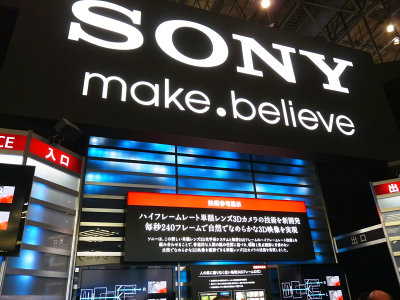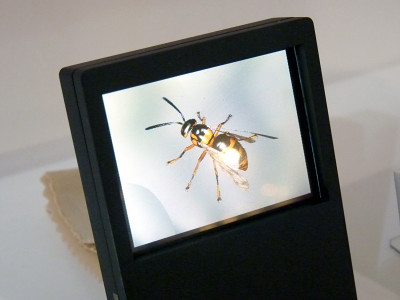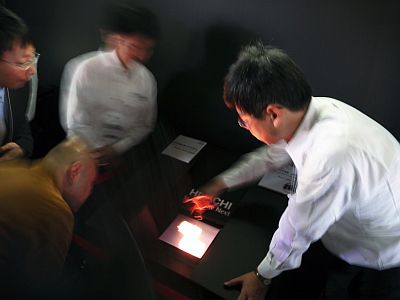How to do not to transiently end a 3D movie boom, how to do history and technology
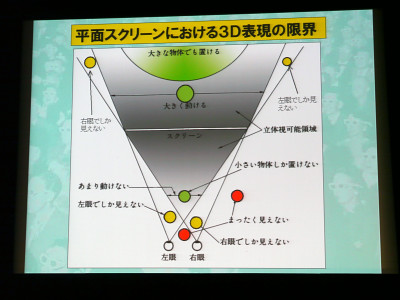
Recent works of American studios such as Disney, DreamWorks, Sony Animation, Blue Sky are nearly 100% stereoscopic images, especially this year is said to be the first year of 3D this year. According to Takayuki Oguchi, a journalist at video creators, these booms have happened many times in the past and have all failed.
At the Tokyo International Anime Festival 2010 autumn symposium "3D (stereoscopic video) technology and history", I reviewed this history and talked about what was not going on and what should I do in this boom .
The outline of the symposium is as follows.
The symposium was in charge of video creators and journalist Takayuki Okuchi.
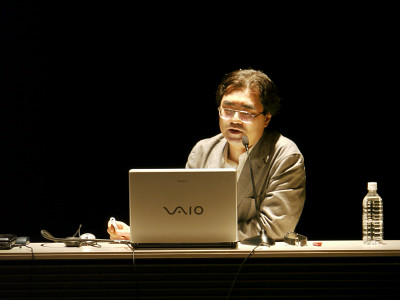
Looking back on the past 3D movie boom, it seems that the 1950s is the first boom, the 1980s the second boom, and the current one is the third boom. This tertiary boom began around 2005 and it has been around since this year. The beginning of the boom has always occurred when a new media appeared, it seems that repeating that it will be called 3D when the movie industry is threatened and there is a situation where something must be done.

Next is a commentary on technology. There are roughly 5 types of 3D display methods currently in use.
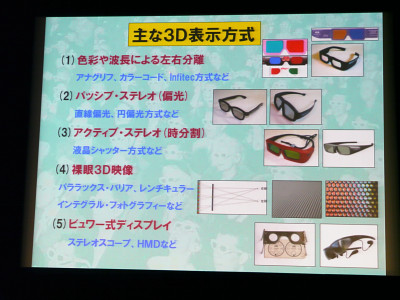
First of all classicAnaglyphThere are red and blue glasses called. This is included in the category of separation by color or wavelength. For example, Dolby 3D uses a filter called Infiphic, so it is also included in this category. Well-known is the way polarized filters are used, recentlyPassive stereoIt is said that there are classifications of linearly polarized light and circularly polarized light among them.
What is most commonly used in recent 3D TVActive stereo. I used liquid crystal shutter eyeglasses in a way to divide by time, but there used to be a way not to use a liquid crystal shutter once. Currently very attentive isNaked eye 3Dis. Especially in the field which is receiving dramatic attention in Nintendo 3DS, there are parallax barrier, lenticular, integral photography, and others.
The first thing that started as a 3D display method isViewer type. In 1832 a British scholar named Charles Wheatstone made it and was given the name stereoscope. Placing the mirror in the middle, standing two strokes of hand-drawn illustrations on both sides. The stereoscope is a very big substitute and it seems to be very troublesome to handle, but a student called rival Blue Star made something of binoculars size and it became explosive. After that it seems that it began to point to this thing if it says stereoscope.
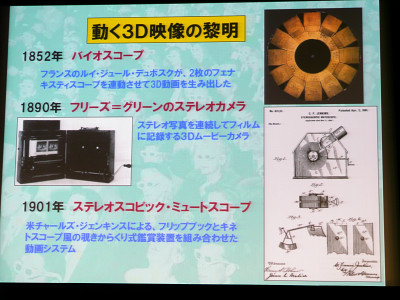
Dawn of a 3D movie
Anaglyph appeared in 1853 when it was applied as red and green inks and applied to magic lamps. In fact in France in the 19th century, the stereoscopic video industry was being carried out as a magical show. However, until the 1920s, until the 1920s, the film advanced with progress without advancing the standard of the film developed by Edison and Eastman Kodak with a 4-performance 35 mm, 16 frames per second, screen ratio of 4: 3 It seems there was. It appeared here that the radio station was born. Mr. Oguchi says, "When the movie industry is threatened and you have to do something, 3D will be called," and Hollywood made it as a countermeasure against radio using 3D animation with anaglyph That was.

The advantage of anaglyph is that you do not choose a screen, even a television or printed matter that is not a screen is also possible. Several short stories were made in the 1920s and imported to Japan in the 1930s.
Work of the time "Audioscopiks (title: jumping out movie)". According to Mr. Oguchi, because they had almost no content and just did jump out, prejudice that "movies pop out of a stereoscopic movie", 3D is the reason to have a bad prejudice of seeking depths before and after It seems I got it.
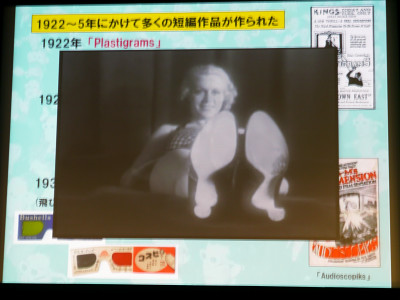
Passive stereo appeared at the end of the 1920s. Two ways of using a polarizing filter, "use two projectors", "need a silver screen (normal screen is a white screen)" was a bottleneck. It is Edwin Land who put it to practical use, originally though it seems that he took a patent to reduce the lag difference of the headlight of the car, but that did not go well and the patent for color stereoscopic movies that we had taken together I lived.
Polarization filters are not treated as military technology for a while due to World War II and will come out for the time being after the war, at the exposition called the British festival of the reconstruction of London. There is a pavilion of the setting called "telekinema" of the future movie theater, there are 4 channel surround sound equipment, television relay, video projector using the idle hall etc. It was a system which can show the situation of the venue in real time That's right. It is also equipped with passive stereo equipment, it is a waste to break so because it is too properly, it remained as a permanent building after the exposition.
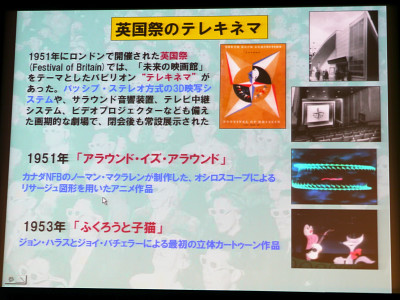
◆ First 3D movie boom
In the 1950s the number of TVs increased rapidly, while the movie theater rapidly declined. The film company remembered the crisis and tried to find a way of life on a stereoscopic image or a widescreen just like in the 1920s. In 1953, 40 stereoscopic films were made even for feature length only, but in the following year the number decreased to 21 long. These 21 pieces were only screened at the beginning of the year, and it seems that the boom had only a year and a half. Just this time, it seems that 3D animation was also mass produced, and it was this time that Disney's first 3D animation "melody" was made.
One of the reasons why the first boom came to an end in a blink was "Synchronization gap". At the time the projector needed to change the film, the projector ordinarily switched between the two projectors to realize continuous screening but in order to multiply the left and right images for the 3D movie with the left and right projectors respectively I had to put out the visitor every 30 minutes when the film was over and to change the film, and it seems that there were times when the film flew and the picture did not match as the film broke. In addition, it seems that one reason is that reputation for glasses is troublesome, so that diseases may be transferred as they are used again. Furthermore, as the boom began suddenly, there was no period to make the content firmly, there were frequent occurrences such as placing sticks out, just throwing stones.
The reason for the biggest failure is "existence of rival." In particular, the cinemascope system, which uses an ordinary 35 mm 4 perforation film and compresses an image using an anamorphic lens at the time of shooting, can be done simply by attaching a lens to a projector or a camera as it is, so each film company As a result of introducing it all at once, 3D seems to have been forgotten.
◆ Porn movies that saved 3D film extinction
A way to manage this is an anaglyph of red and blue stereoscopic video, but the anaglyph is not fusion of images in the brain, but the condition of red and blue is constantly switching in the head, I get tired when I look for a long time. As a result, filmmakers can view special images by setting up glasses as the main character wears masks or wear glasses, for example, as a setting for showing stereoscopic images for a short time, And so on.
This method was used, for example, in the "Toei Manga Festival", but the one most commonly used was the porn industry. The work "The Stewardess" was made with a low budget of 100,000 dollars, but it sold $ 30 million with a box office show of only San Francisco and Los Angeles, and even hit the world. It seems that there was also a time when the pornographic movie itself was very rare at the time when the harsh movie regulation of Hayes code was abolished and switched to the rating system. Stimulated by this work, 3D porn movies were made even in the UK and West Germany. The work "Congenital exposure frenzy" cost money and it seems that it was made of 70 mm film.
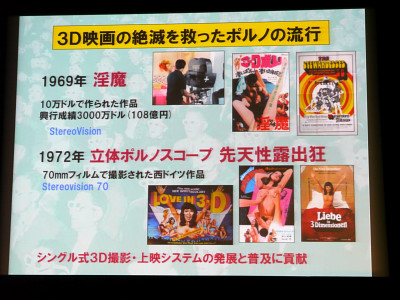
It was an era when two cameras and projectors were needed, but it seems that pornography was used as a test case just as a single type system was developed. Photographers, directors and producers of this era are becoming the heavyweights of the current 3D industry, it seems to be the base of current technology of technology, and it can not be stupid because of pornography.
◆ 2nd 3D Movie Boom
The second 3D movie boom overlaps with the time when cable television came out. This did not come out against the cable television, but while broadcasting an old movie with a specialized movie channel on cable TV, when broadcasting a 50's stereoscopic movie, "If it was anything But I had an opinion saying "I can not see it out properly", and when I did the original polarized glasses with anaglyph, it seemed pretty well. So, as a result of the rapid progress of the 50's stereoscopic movies, it seems that we entered the second boom as the stock of the work disappeared and we had to make a new work.
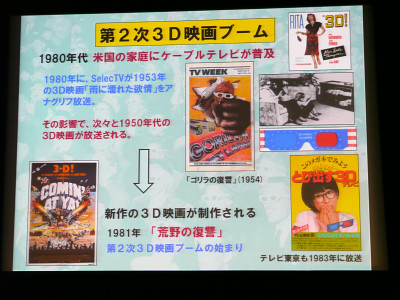
In the 2nd 3D movie boom that began with "revenge of the wilderness" in 1981, "Friday the 13th Part 3", "Super Stereoscopic Film Jaws 3", "Emmanuel" etc. were produced, but most of them are bad B He said that the movie did not accompany quality, and gradually declined.
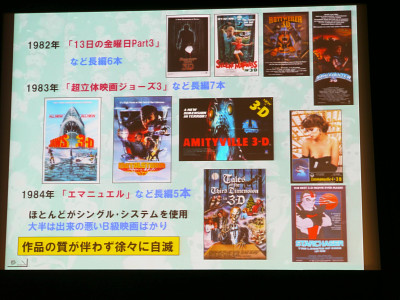
About autostereoscopic images
The autostereoscopic image has an old history, it seems that the idea of parallax barrier came out in 1692. Although it seems that it was a slightly different way of thinking from "stereoscopic view" that "the picture seems to be different from the right and the left", it is said that it will be stereoscopic when viewing through the interdigital barrier sorting the photograph vertically and rearranging the left and right As applied, the American inventor Fleederic Ives got a patent. I've got a large amount of naked eye 3D patents and parents and invented various systems.
Because there was a problem that the parallax barrier was somewhat dark, Lippmann invented integral photography that makes stereoscopic vision using a fly eye lens, but it was not realized then at the time because the lens processing technology was difficult . In 1915, Hess of Switzerland developed a lenticular method that spreads a semi-cylindrical lens in order to make it practical.
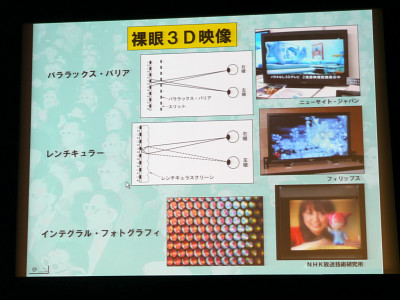
Currently, parallax barrier is put to practical use in the field of digital signage, and it seems that stereoscopic displays such as Nintendo 3DS and Fujifilm's stereo camera are realized with this system. Also, the lenticular method seems to have been used for 3D television (currently assigned to Samsung) which Philips had released until last year. Integral imaging of Toshiba 3D TV which was talked about at CEATEC the other day is actually a lenticular system in fact.
It seems that integral photography seems to need a future technology to say that it is impossible to put it into practical use, and if the number of pixels does not rise by about two orders of magnitude, it will not be like the current television image quality.
◆ Viewer type 3D display
Originally thought of a head mounted display (HMD) was inventor Morton Heilig, was in 1957. Hai Rig has developed this virtual reality system that develops this, not only the stereoscopic image, but also the feeling of the wind using the fans, the smell comes out, the vibration is felt, but it succeeds did not.
The "ultimate display" that Ivan Sutherland had been studying was actually completed by Jim Clark who created Silicon Graphics, Inc. Mechanical sensors were installed, and when moving the face, CG moved in real time. An idea to apply this to the game came out right away, and in 1991 W Industry's company in the United Kingdom developed a game system called "VIRTUALITY". It seems that it was imported to Japan, but CG is cheap and polygon is coarse and it can not bear to see, so it seems that the company collapsed soon.
Nintendo's home video game machine "Virtual Boy" also failed due to the problem of one LED red.

It seems that SANYO was the most motivated at that time at 3D. It seems that he made LV player without flicker, made lenticular type naked eye display, made high definition, and made naked eye stereoscopic liquid crystal display in 1994. However, Mr. Oguchi tells us why Sanyo has not made any content as a reason for not succeeding as one of them.
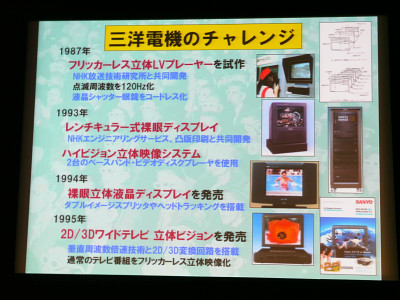
This is similar to Sharp, we developed a naked-eye stereoscopic liquid crystal using a parallax barrier, mounted it on a mobile phone, released a notebook PC · Mebius liquid crystal as a parallax barrier system, but again due to the content problem He heard it. Sharp has improved this technologyExhibited at CEATEC this yearAnd it is said that Sharp is offering liquid crystal of Nintendo 3DS as well.
◆ Screen problems
There was a screen problem in stereoscopic video, there was an example that throwing stones and sticking out with story directing talks, but because this is a square screen there is circumstance that there is no choice is. 3D only fits in the space called the "viewpoint pyramid" connecting the eyes and the corners of the screen, so it can only be achieved with stones or sticks there.

Because I know it that the recent movie goes in the depth direction rather than jumping out. Then, it seems that the job that Oguchi was doing at Fujitsu was to use the dome screen, as it would be okay to stop the square screen to solve it. I can experience in the movie "I will enter into the image" "Image comes through from side to side and comes out from behind and goes out before", I still have experience at the National Museum of Emerging Science and Innovation and the Science Museum is.

◆ Third 3D Movie Boom
The 3 rd 3D movie boom began with the proposal of George Lucas, James Cameron, Robert Zemeckis and others "in 2005 to recall customers by 3D movie" in 2005 when the movie's box office income got tangled up .

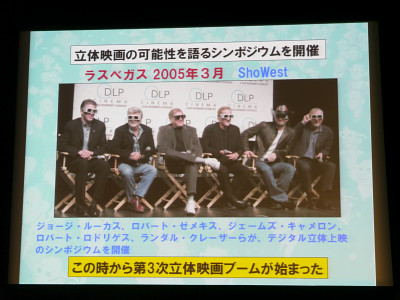
A new projector system is also appearing, for example "Real D" uses a circularly polarizing filter and does not emit flicker (flicker). Besides this, there are Dolby 3 D method, master Image method, IMAX digital method, etc. The IMAX digital system became very popular at the time of the movie "Avatar" and it became such a situation that tickets can not be bought, and currently the corresponding theater corresponding to 4 buildings will be about 13 in the next year. Also, recently the "Technical 3D System" usually allows films to be screened, so the cost is very cheap.
Mr. Oguchi proposed what to do in order not to end this boom as a failure, that Mr. Oguchi proposed that "movies are to be seen in glasses". Instead of denying glasses, it is the idea to make customers a glasses, so to do that it is necessary to improve the fitness of the 3D glasses, to reduce the weight, and to match the size to the customers I continued it. Also, it was funny that the fee is higher in 3D, so it was hard for you to wear glasses, so the suggestion was also made that 3D is cheaper or that such care is necessary.
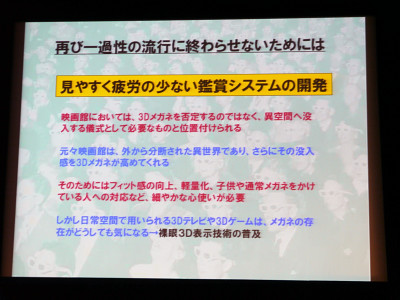
Recently 3D (three-dimensional) movie that attracts great attention, such as "Avatar" becoming worldwide box office revenue number 1, etc. As Mr. Oguchi says, although there are opportunities to spread so far, there is a history that it passed away as a transient boom due to technical problems and quality of work, respectively. Even in this boom, there are works firmly made in 3D like the "avatar" "biohazard 4", but on the other hand, with an inexpensive 2D / 3D conversion, "I saw a 3D version with paying high money It is regrettable that some works such as having no meaning to watch in 3D at all are disappointing but it is disappointing that viewing in 3D is not burdensome, so as not to say that 3D was unnecessary after all, in order to firmly fix I want you to take measures of.
Related Posts:
